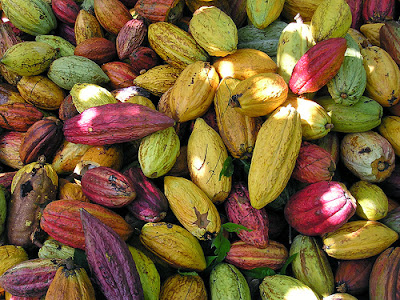Part of the translation process is tracking down references, which are included here as notes. I've also added photos to bring the story to life. For starters, regional differences in the appearance of the Rosca are so dramatic that I didn't recognize some of them as Rosca. But I found a photo of the Rosca we're familiar with from Michoacán.
 |
| Rosca de Reyes with Three Wise Men |
Indisputably, the quintessential Twelfth Night pairing is dunking a piece of Rosca de Reyes in a frothy hot chocolate. It's a cross-cultural tradition that unites the exquisite prehispanic concoction with the bread that arrived from Europe along with wheat. In itself, the custom of the ring-shaped bread commemorating the arrival of the Magi Kings to honor the newborn Son of God, is said to have its origin in the Roman Saturnalia, celebrations dedicated to the god Saturn. At that time, round cakes with figs, dates and honey were prepared and distributed to the people.
Note: A god in the ancient Roman religion, Saturn's multiple associations and long history make him a complex figure. Known since ancient times as Saturnius Mons, Saturn was the first god of Rome and was seen as a god of generation, dissolution, plenty, wealth, agriculture, periodic renewal and liberation. Later he came also to be a god of time. His reign was depicted as a Golden Age of plenty and peace. The Temple of Saturn in the Roman Forum housed the state treasury. In December, he was celebrated at the Saturnalia, a time of feasting, role reversals, free speech, gift-giving and revelry. Saturn the planet and Saturday are both named after the god.A fourteenth century testimony from the Kingdom of Navarre in Spain describes a ringed pastry containing a dried bean. When served, the child whose piece contained the bean was declared King of Fava [fava bean, native to North Africa, home of the Moorish invaders who occupied Spain for 800 years]. The tradition arrived in our country in the sixteenth century and the fava bean became the niñito, infant boy, who is usually of porcelain or ceramic.
 |
| Porcelain Figure of the Niñito, Little Boy |
Note: A reader wrote wondering if cocaine comes from cacao leaves. The short answer is, no, they are two different plants:
- Chocolate comes from the cocoa tree (Theobroma cacao);
Just as today paper money is counterfeited, at that time the same was done with the cacao. In his epic summary, "A History of the Things of New Spain," the remarkable Friar Bernardino de Sahagún mentions:
- Cocaine comes from the leaves of the coca plant (Erethroxylacaea coca), which is a shrub.
"The good trader in this commodity ... the almonds (sic) that he sells are all plump, still in clumps and picked over. He sells everything by itself, setting to one side the plump ones in clumps and separating out those that are thin, hollow or broken. The bad trader sells the fake ones, roasting them and even browning them to make them look good. Sometimes he soaks them in water so they appear plump ...", and he goes on to list in detail all the tricks of dishonest traders.
In Mexico seven major species of the blessed bean are grown. The famous Swedish botanist Carl von Linée classified them as Theobroma, which in Latin means "food of the gods." The origin of the word xocóatl [sho-KO-aht] has too many versions [to describe here]. Hispanized, it became chocolate. It was introduced to Europe by Hernán Cortés, who sent it as tribute to Spain. ... [Spanish original]
In closing, I'd be remiss if I failed to mention that the winter festivities that begin in early December with Advent don't really conclude until February 2 on Candleária, or Candlemas. Commemorating the ritual purification of Mary, 40 days after the birth of her son Jesus, Candlearia also marks the ritual presentation of the baby Jesus to God in the Temple at Jerusalem.
According to custom, whoever gets the niñito in his or her slice of Rosca is responsible for preparing the tamales that are the traditional food for Candlearia. Every year Coyoacán sponsors a Tamal Fair, which we thoroughly enjoy.
When people ask us why we enjoy Mexico, one response has to be this tireless communal pleasure in the seasonal fiestas. Last year, the "largest Rosca in the World" was laid out all around the Zócalo, Mexico City's Main Plaza. Measuring 720 meters [787 yards; almost 8 football fields] in length and about 90 centimeters [37 inches] wide, the Rosca weighed approximately 1,375 kilograms [3,000 pounds], which was enough for more than 300,000 citizens to enjoy a slice.
How was it prepared? More than 2,000 volunteers each donated 7 hours; total cost was estimated by the National Chamber of the Bakery Industry to be 1,142,800 pesos [USD $87,296].
 |
| 2012 Giant Rosca. Here's a delightful photo gallery of the 2013 Rosca in the Zócalo. |
Given that this is Day 1 of the Gigantic Deep Freeze in what appears to us to be the entire Eastern two-thirds of the United States, it's a good time to be down here. May you all Stay Warm and Stay Safe! Now that I think of it, it's a great day for a steaming, frothy cup of Hot Chocolate! ¡Saludos de México!

.jpeg)

No comments:
Post a Comment